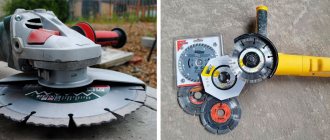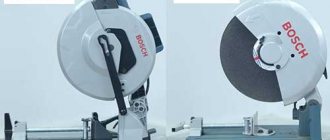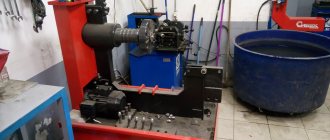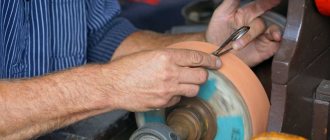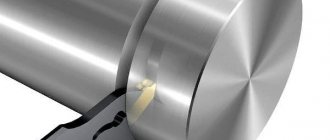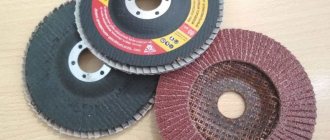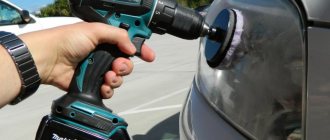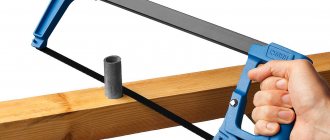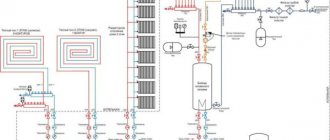Very often, during renovation, demolition or construction of houses, concrete walls are cut. Today, this procedure can be performed using several methods: using a diamond tool, a water jet, or an oxygen lance.
The most popular of them is the use of diamond tools.
A diamond wheel for a grinder allows you to process a concrete product in such a way that the surface is perfectly smooth without various side effects: cracks, noise and dirt that are in the affected area. This device cuts reinforced concrete, grinds concrete floors, and grooves communications for shrinkage.
In order for the surface to be as smooth as possible, it is necessary to choose the right discs, having familiarized yourself with their classification in advance. An informed choice will save money and reduce labor costs (the tool will have to be changed less often if its durability is higher).
Types of diamond blades for metal
Diamond blades vary in purpose, design, and manufacturing technology.
- If they are a round steel plate with a strip of diamond grains applied to its outer edge, they are called solid.
- If they have slots from the edge to the center for approximately 10–15% of the diameter, necessary for heat dissipation, they are called segmented. They can operate at high speeds.
- If an oblique notch is applied to the surface, then this is a turbo. They are more durable.
- A diamond cutting disc with slots and serrations is the most productive and is called turbo-segmented.
The marginal strip of grains is called the cutting edge. Diamond grains come in different sizes and are attached to metal in different ways. The size of diamonds determines work efficiency and working life. Large grains wash the metal being processed better, but wear out more quickly. Small ones work more accurately on metal, but their productivity is lower. But they have a higher working resource.
Diamond grains are attached to a steel plate in various ways: soldering, laser welding, and electroplating. The purpose of the tool also depends on the method of fastening. Discs with soldered grains are used in conjunction with water cooling. Galvanically bonded grains work well with soft materials. Diamond blades with welded grains are good for cutting hard metal alloys.
Diamonds are fixed in the working rim in a certain order. There are disks with a uniform distribution, when segments of the same length contain the same number of crystals.
But there are products in which diamonds are placed at a certain frequency (sandwich). They have greater productivity, exert less pressure on the tool, are better cooled and distribute forces more evenly.
How to replace
The grinder disc is a consumable item. Therefore, it has to be changed frequently. There is a simple algorithm in which an important role is played by the original design of the key supplied to the consumer along with the grinder.
- — The protruding rods of a special key are installed in the grooves of the fastening nut.
- — At the same time, press the lock button located on the gearbox housing. It will lock the rotor from turning.
- — Turn the key counterclockwise to release the fasteners of the worn disk.
- — The old disk is replaced with a new one of the same technical characteristics and size. The new disk is installed with the markings facing out to remind you of the disk parameters and for other good reasons (see explanation in the video above).
- — The fastening nut is first tightened by hand and finally tightened with a special wrench.
The Bulgarian is ready to continue fulfilling its functional purpose.
Main advantages and disadvantages
Diamond cutting discs are a universal tool. They are suitable for cutting not only metal, but also other materials of increased hardness: brick, reinforced concrete, foam concrete and others. The advantages of this tool include:
- increased geometric cutting accuracy;
- flat surface;
- almost silent operation.
The diamond blade does not exert pressure on structures adjacent to the cutting surface and does not change the structure of the material during operation. At the same time, significantly less time is spent on completing the work than when using other tools. The diamond wheel operates in the absence of a flow of sparks, and, as a result, there is no burning smell.
The cost of work using diamond blades should be calculated for each specific job.
The disadvantages of such a device include its high cost, but the working life of a diamond cutting tool significantly exceeds (almost 70 times) the working life of abrasive discs performing the same work. Equipment downtime is reduced by reducing the frequency of tool replacement. When using active cooling, it is possible to increase rotation speed and productivity. Throughout its service life, the tool retains its geometric characteristics.
How to choose
The main criterion for choosing the disk size will be the nature of the work performed. In the household, these will be circles of smaller diameters; in a production environment, a tool of large diameter (230 mm) is used.
In addition to the dimensional characteristics, you should carefully check the compliance of the disc material with the material of the workpiece being processed.
Another determining factor is the power of the grinder. It is directly related to the weight and overall characteristics of an angle grinder. With approximately the same characteristics, preference should be given to a lighter specimen.
Main characteristics and markings
One of the main characteristics of a diamond blade is its size - the outer diameter, on which the maximum cutting depth depends. For a universal grinder (angle grinder, grinder) there is a size range: 115, 125, 180 and 230 mm. Powerful metal cutting machines are equipped with devices with a diameter of 150, 300 or more millimeters. The mounting holes located in the center are used for installation on the mechanism shaft and have diameters of 22.2 or 25.4 mm. Like any product, a diamond cutting disc has a set of basic characteristics:
- type;
- size;
- the abrasive material from which it is made;
- the material for which it is intended for processing;
- grain;
- hardness;
- type of ligament;
- maximum speed;
- accuracy class;
- manufacturer.
These characteristics are encrypted in the form of alphanumeric markings, which are present on each diamond blade. The rules for labeling do not have strict regulations. Each manufacturer designs it differently, but the main characteristics are always present.
- Disk type. In theory, there should be a digital designation: straight profile;
- cutting;
- with recessed center.
- D – outer diameter;
- ceramic bond – V (K – old designation);
bakelite bond – B (B – old designation);
What does the marking on a diamond cutting blade mean? As an example, we consider the symbols printed on the tool of the Russian manufacturer ISMA flex (see figure).
2302.522.2 14A63H39 BU 80 m/s class 2 according to GOST 21963-82, where:
- 2302.522.2 – (DxTxH) – dimensions: diameter, thickness and diameter of the mounting hole.
- 14A – grade of grinding material – in this case, electrocorundum is normal.
- 63N – grain size – medium here.
- 39 – sound index.
- B – bond – bakelite.
- U – the presence of a reinforcing element – fiberglass reinforcement.
- 80 m/s – operating speed.
- Class 2 imbalance.
- GOST 21963-82 is a normative document.
Let's cut!
Here are some typical situations in which you might encounter problems cutting concrete:
- Pouring the foundation. Sometimes calculations are inaccurate, or unexpected adjustments are made to the plan. But the foundation has already been poured and has had time to harden. How to adjust it to new sizes?
- Redevelopment of a city apartment. You decide to expand or move the doorway. How to make a neat hole of the required diameter in a reinforced concrete wall?
- Redevelopment of a retail or exhibition hall. Is it possible to cut off part of the wall without damaging the rest?
- Dismantling of structures. Some elements must be dismantled carefully if there is a risk of damage to nearby objects.
All these problems are now successfully solved by diamond cutting. This is cutting concrete or reinforced concrete using discs with a special coating - made of artificial diamond. The tool that can be used for such work ranges from a regular “grinder” (also known as an angle grinder) to more specialized and expensive saws or concrete cutters. The choice of tool depends on the desired cutting depth. A grinder can cut through concrete no more than 80-100 mm, but for everyday tasks this is enough.
We have decided on the tool. But it is equally important to choose the right type of disk.
Diamond blade manufacturers
The following companies are deservedly popular among manufacturers:
- Bosch. German leader in the production of power tools and related materials.
- FIT. The Canadian company produces tools for professional and household use.
- Dremel American company producing high quality power tools.
- Husqvarna. A Swiss company that is known for its high performance and level of durability.
- MESSER. A Korean manufacturer that produces a wide range of attachments for grinders.
- Zubr. Russian company producing power tools and cutting equipment.
- Hitachi Power Tools, Luga Abrasiv Extra. Has excellent value for money.
Diamond cutting discs are an effective tool with high productivity and provide comfortable conditions when performing work. Do you have experience working with them? Be sure to share it in the comments to this article.
Features of working with the tool
In order to make the most of the working life of an expensive diamond tool, you need to adhere to important rules for its operation:
- cutting reinforced concrete should be done in successive shallow passes;
- the first pass is performed to a depth not exceeding 10 mm;
- the depth of each subsequent cut should not exceed 15 mm.
Before starting work, you need to accurately determine the brand of concrete and its frame, since each material requires different types of diamond cutting tools. If the concrete is reinforced with steel rods and the thickness of the part to be cut exceeds 100 mm, a special disk must be used.
It is also taken into account whether the concrete mass is fresh or old to be cut, because over time the properties of this material change. Old concrete is always stronger than fresh concrete; cutting it requires more expensive tools. The larger the cutting wheel's heavy-duty filler, the slower the cutting needs to be.
Learning to use straight tile cutting
This is the most popular and reliable option. Any type of grinder can be used, but much depends on the material: ceramics, tiles or porcelain stoneware. In any case, such work is characterized by various difficulties.
How to do it:
- If the quality is not particularly important, since it will be hidden by the baseboard, then it is enough to step on the tile with your foot;
- For more reliable fixation, clamps are used. The tile is fixed. But for small cuts it is convenient to use a workbench; for cutting to the full length, such equipment is not suitable;
- To ensure high precision cutting based on the line, a steel angle or tape is used. To do this, fastening is done with clamps. Cutting is done directly based on the angle. The disk is driven at a slight angle of 10 - 15 degrees in relation to the fastening;
- To create a straight cut, a special technique is used. The tiles are cut along a securely fixed metal corner;
- To reduce the likelihood of damage to the cladding, a double cut is performed. A passage is made along the front side with a minimum immersion of up to 2 - 3 mm; this will protect against chipping. Then the tile is cut from the back.
Tip: You don't always have to cut the tile all the way through. In some cases, it is convenient to make an incision 2/3 of the thickness to create the possibility of a fracture, by pressing on the edge with pliers or another reliable method.
You should always cut away from you. It is more profitable for beginners to get the job done thanks to several passes. The first is necessary to create a shallow cut of 1 - 5 mm, the next ones assume a similar depth of immersion into the material until the tile is completely cut off.
We follow safety precautions
Do not forget that an angle grinder can cause injury if used incorrectly. In addition, a lot of dust and fragments are created.
Means of protection:
- A mask and glasses are required;
- Special suit to cover arms, legs;
- Mittens or gloves;
- It is prohibited to work with a broken angle grinder or with a missing protective casing without additional methods of protection against injury from the cutting element;
- The cutting wheel can only be replaced after disconnecting the cord from the electrical network. Connection is allowed when the reliability of the fixation is checked and the key is removed;
- Do not use a defective disc. Before starting work, it is necessary to inspect the equipment for damage. Only after this is the work allowed to be completed.
Now we realize that it is advantageous to cut tiles with a diamond-coated disk. We figured out how to choose the necessary equipment. We looked at a simple and popular method of cutting tiles. Learned to follow safety precautions.
